Exchange Currency
Kenyan shilling
The shilling is the currency of Kenya. It is divisible into 100 cents.
In 1897 Harry Jackson the leader of the British East African Protectorate (B.E.A.P.) introduced a new currency called “Specie” and “Pice” but it was not successful and hence in 1905 the Indian Rupee was made the official currency of the B.E.A.P. (Kenya- Uganda). They were in the following denominations.
The Indian Rupee was abolished after Kenya became a crown colony in 1920 when the Imperial British East Africa’s (IBEA) mandate was terminated. A central body known as the East African Currency Board was then established to oversee the issuance of currency in the region. The Board comprised of four commissioners who reported to the secretary of state for colonies under the advisory of the Bank of England. Replacement of the Indian Rupee was to be done using the East African Protectorate Rupees. This was however short-lived as the East African Florins were instead introduced.
On January 1, 1922 the shilling equivalent was introduced in all the three East African countries and by June 1923, the E.A. shilling was firmly established as official currency in Kenya, Uganda and Tanganyika.
In 1964 after the independence of Kenya, Uganda and Tanganyika, there was a desire to establish a common East African Central Bank. Interim currencies were therefore introduced by the EACB to circulate within the region. For banknotes, the interim currency was commonly known as the Lake Victoria Money because of the background of Lake Victoria on the notes. The Lake Victoria designed notes were in the denominations of 5, 10, 20 and 100 shillings. There were also a number of coins minted and referred to as the “Uhuru” coins since they too had no head or monarch on them.
Kenya began printing and minting its own currency in 1966 under the mandate given to the Central Bank of Kenya in the Central Bank of Kenya Act cap 491. The initial issue of Kenya shilling notes were in the denominations of 5, 10, 20, 50 and 100 shillings, all bearing the portrait of the First President of Kenya, H.E. Mzee Jomo Kenyatta in the front, and diverse scenes of economic activities in Kenya at the back. Denominations have progressively changed since then. Current denominations of banknotes and coins in circulation are as follows:- Coins – 5cent, 10 cent, 50 cent, 1 shilling, 5 shilling, 10 shilling, 20 shilling and 40 shilling Notes – 50 shilling, 100 shilling, 200 shilling, 500 shilling and 1,000 shilling. More details on the History of Kenyan Currency can be found by contacting the Bank.
Between 1967 and 1978, the portrait of Jomo Kenyatta, the first president of Kenya, originally appeared on the obverse of all of independent Kenya's coins. In 1980, a portrait of Daniel arap Moi replaced Kenyatta until 2005, when the central bank introduced a new coin series that restored the portrait of Kenyatta. The coins are 50 cents and 1 shilling in stainless steel and bi-metallic coins of 5, 10 and 20 shillings. A bi-metallic 40 shilling coin with the portrait of President Kibaki was issued in 2003 to commemorate the fortieth anniversary of independence (1963-2003). New coins with the image of Kenyatta were issued in 2005.
Summary info
Summary information about Kenyan shilling- ISO 4217 Code:
- KES
- Currency sign:
- KSh
- Country:
- Kenya
- Subunit:
- cent
- Coins:
- 50 cent, 1 shilling, 5 shillings, 10 shillings, 20 shillings, 40 shillings
- Banknotes:
- 50 shillings, 100 shillings, 200 shillings, 500 shillings, 1000 shillings
- Central bank:
- Central Bank of Kenya
History
Entry of what is commonly considered as real currency in Kenya can be traced back to 1800 - 1850 when the Maria Theresa Thalers were introduced in the Kenyan coast. The Thalers were 18th and 19th Century silver coins used by Indian, Greek and European merchants at the Eritrean and Kenyan coasts. Despite the Thaler’s popularity in the East African Coast, it was not able to penetrate upcountry. The Indian Rupee which was used for payment of Indian workers during the building of the Kenya – Uganda railway in 1896 and managed to move inwards becoming acceptable by the African population who in various mother tongues called it different names such as “Rupia” or “Pesa”.In 1897 Harry Jackson the leader of the British East African Protectorate (B.E.A.P.) introduced a new currency called “Specie” and “Pice” but it was not successful and hence in 1905 the Indian Rupee was made the official currency of the B.E.A.P. (Kenya- Uganda). They were in the following denominations.
The Indian Rupee was abolished after Kenya became a crown colony in 1920 when the Imperial British East Africa’s (IBEA) mandate was terminated. A central body known as the East African Currency Board was then established to oversee the issuance of currency in the region. The Board comprised of four commissioners who reported to the secretary of state for colonies under the advisory of the Bank of England. Replacement of the Indian Rupee was to be done using the East African Protectorate Rupees. This was however short-lived as the East African Florins were instead introduced.
On January 1, 1922 the shilling equivalent was introduced in all the three East African countries and by June 1923, the E.A. shilling was firmly established as official currency in Kenya, Uganda and Tanganyika.
In 1964 after the independence of Kenya, Uganda and Tanganyika, there was a desire to establish a common East African Central Bank. Interim currencies were therefore introduced by the EACB to circulate within the region. For banknotes, the interim currency was commonly known as the Lake Victoria Money because of the background of Lake Victoria on the notes. The Lake Victoria designed notes were in the denominations of 5, 10, 20 and 100 shillings. There were also a number of coins minted and referred to as the “Uhuru” coins since they too had no head or monarch on them.
Kenya began printing and minting its own currency in 1966 under the mandate given to the Central Bank of Kenya in the Central Bank of Kenya Act cap 491. The initial issue of Kenya shilling notes were in the denominations of 5, 10, 20, 50 and 100 shillings, all bearing the portrait of the First President of Kenya, H.E. Mzee Jomo Kenyatta in the front, and diverse scenes of economic activities in Kenya at the back. Denominations have progressively changed since then. Current denominations of banknotes and coins in circulation are as follows:- Coins – 5cent, 10 cent, 50 cent, 1 shilling, 5 shilling, 10 shilling, 20 shilling and 40 shilling Notes – 50 shilling, 100 shilling, 200 shilling, 500 shilling and 1,000 shilling. More details on the History of Kenyan Currency can be found by contacting the Bank.
Coins
The first coins were issued in 1966 in denominations of 5, 10, 25 and 50 cents, and 1 and 2 shillings. Twenty-five cents coins were not minted after 1969; 2 shillings coins were last minted in 1971. In 1985, 5 shillings coins were introduced, followed by 10 shillings in 1994 and 20 shillings in 1998.Between 1967 and 1978, the portrait of Jomo Kenyatta, the first president of Kenya, originally appeared on the obverse of all of independent Kenya's coins. In 1980, a portrait of Daniel arap Moi replaced Kenyatta until 2005, when the central bank introduced a new coin series that restored the portrait of Kenyatta. The coins are 50 cents and 1 shilling in stainless steel and bi-metallic coins of 5, 10 and 20 shillings. A bi-metallic 40 shilling coin with the portrait of President Kibaki was issued in 2003 to commemorate the fortieth anniversary of independence (1963-2003). New coins with the image of Kenyatta were issued in 2005.
Banknotes
In 1966, the Central Bank of Kenya issued notes in denominations of 5, 10, 20, 50 and 100 shillings. 5 shillings notes were replaced by coins in 1985, with the same happening to 10 and 20 shillings in 1994 and 1998. In 1986, 200 shillings notes were introduced, followed by 500 shillings in 1988 and 1000 shillings in 1994. As with the coins, Mzee Jomo Kenyatta appeared on the banknotes issued until 1978, with Daniel arap Moi's portrait replacing him in 1980. In 2003, after Mwai Kibaki replaced Moi as president, 5, 10, and 20 shilling notes from the 1978 series with Kenyatta's picture that had been in storage were issued, and circulated for a time. A new series of notes was then introduced on which Kenyatta reappeared with denominations of 50, 100, 200, 500 and 1000 shilling. The issue of 12 December 2003 commemorates the "40 years of Independence 1963-2003". The banknotes are printed in Nairobi by De La Rue.KES banknotes pictures gallery
| 50 Kenyan shillings | |
|---|---|
| Banknote of 50 Kenyan shillings has dimensions 138×72 mm and main colors are bazaar, cinereous, timberwolf and khaki. | |
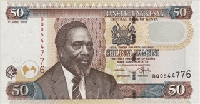 Obverse side of the 50 Kenyan shillings is showing the portrait of the First President of Kenya Mzee Jomo Kenyatta. |
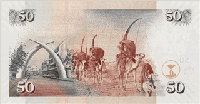 Reverse side of the 50 Kenyan shillings is showing the Mombassa Tusks and Nomads with Camels. |
| 100 Kenyan shillings | |
|---|---|
| Banknote of 100 Kenyan shillings has dimensions 141×74 mm and main colors are old lavender, dim gray, platinum and timberwolf. | |
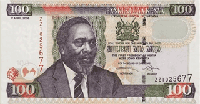 Obverse side of the 100 Kenyan shillings is showing the portrait of the First President of Kenya Mzee Jomo Kenyatta. |
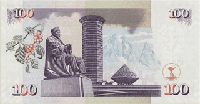 Reverse side of the 100 Kenyan shillings is showing the Kenyatta International Conference Centre and the Statue of Kenya’s founding President. |
| 200 Kenyan shillings | |
|---|---|
| Banknote of 200 Kenyan shillings has dimensions 144×76 mm and main colors are grullo, pastel gray, gainsboro and timberwolf. | |
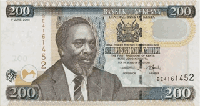 Obverse side of the 200 Kenyan shillings is showing the portrait of the First President of Kenya Mzee Jomo Kenyatta. |
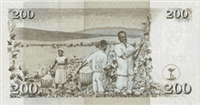 Reverse side of the 200 Kenyan shillings is showing the cotton picking. |
| 500 Kenyan shillings | |
|---|---|
| Banknote of 500 Kenyan shillings has dimensions 147×78 mm and main colors are camouflage green, dark gray, pearl and cambridge blue. | |
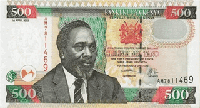 Obverse side of the 500 Kenyan shillings is showing the portrait of the First President of Kenya Mzee Jomo Kenyatta. |
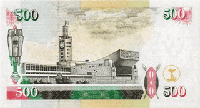 Reverse side of the 500 Kenyan shillings is showing the Kenya’s National Assembly. |
| 1000 Kenyan shillings | |
|---|---|
| Banknote of 1000 Kenyan shillings has dimensions 150×80 mm and main colors are wheat, beaver, snow and pastel gray. | |
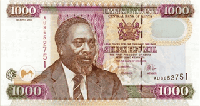 Obverse side of the 1000 Kenyan shillings is showing the portrait of the First President of Kenya Mzee Jomo Kenyatta. |
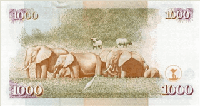 Reverse side of the 1000 Kenyan shillings is showing the Grazing Herd of Elephants. |
Useful links
- About Central Bank of Kenya:
- Central Bank of Kenya
- List of currencies:
- Currencies
- Security and design features of KES banknotes:
- KES banknotes
- KES currency on Wikipedia:
- Kenyan shilling
- Official Website of Central Bank of Kenya:
- www.centralbank.go.ke
- Commemorative coins:
- Commemorative Coins